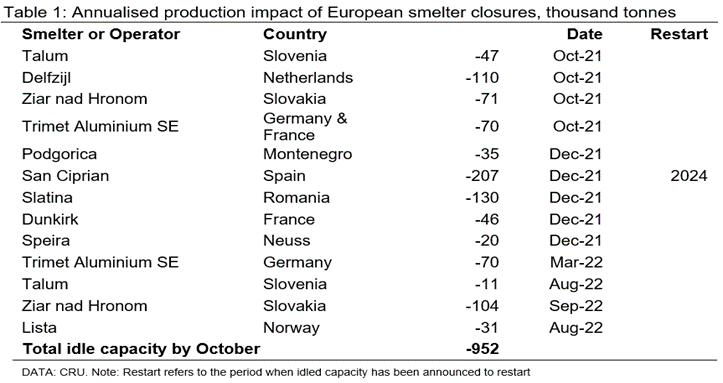Steel Products Prices North America

CRU Aluminum: European Smelting’s Dismal Fall, Gloomy Winter
Written by Greg Wittbecker
September 11, 2022
Natural gas inspired staggering energy prices crush primary aluminum economics
The suspension of gas deliveries through the Nord Stream pipeline has further aggravated an already grim energy situation for European aluminum producers.
Prices for day-ahead power in Western Europe are stunning in their magnitude: 404 euros/megawatt hour were published on Friday for Germany, France, the Low Countries. Southern Norway posted 410 euros.
The casualty list grows by the day across the Continent. Early in the week the AIP smelter in Dunkerque, France, announced a 22% curtailment, or 60,000 metric tonnes (MT) per year. On Thursday, Speira GmbH advised it was cutting 50% of its Neuss, Germany, production, or 72,500 MT/year.
Combined with earlier cuts (shown below), we have now pushed aggregate curtailment to 1.08 million tons in Europe.

Unfortunately, the pain and suffering is not over. CRU estimates that 50% of European smelter output has exposure to spot power prices by the end of 2023. This could represent another 700,000 MT/year of capacity at risk.
Does fear of demand destruction make these curtailments moot?
The London Metal Exchange (LME) has been chosen to shrug off the European curtailments as a secondary consideration to the risk of demand destruction. The LME cash price for primary aluminum has dipped below $2,300/MT, and speculative short positions are building in the contract.
Concerns over demand are certainly warranted. CRU believes that European demand for 2022 will decline 1% relative to 2021. Our 2023 estimate is for a modest 1.3% rise from 2022’s performance, leaving us with a mediocre net growth rate over the 2021 to 2023 period of just 0.7%. These estimates were made before Vladimir Putin decided to extend the Nord Stream shutdown from a pure maintenance-related event into a political statement about “unjustified Western sanctions”.
The longer the shutdown lasts, the less time Europe has to inject gas into reserve storage to get ready for winter. That could suck the life of the manufacturing sector and seriously imperil consumer spending. Goldman Sachs suggested that European household electricity bills could surge by USD 2 trillion in 2023. That would force some serious rationalization for everything from durable goods purchases and entertainment to travel.
How is the US weathering the energy storm?
There is still consternation about the fate of the Century Aluminum smelter in Sebree, Ky., of 220,000 MT/year production. The official company line is that their mix of high value billet is keeping their revenue stream supported enough to get by despite high day-ahead prices.
MISO Indiana Hub prices on Sept. 8 were $118 per megawatt hour for November. The January-February 2023 prices were $167 and $146 per megawatt hour, respectively.
This comes amidst an LME cash price that has faded about $200 per ton in the past two months. Things cannot be comfortable there.
Midwest physical premiums for P1020 ingot are suffering
The Midwest P1020 benchmark for standard melting grade ingot has been steadily dropping with the LME. As we discussed a few weeks back, the market seems to be turning a blind eye to import replacement. We estimate that import replacement today is a full 5 cents/pound above the current $.2470 per pound published premium. There three schools of thought still arguing about what’s driving this:
• An inability to finance stocks with no LME contango is leading long liquidating by traders holding premium long positions.
• There continues to be concern that the Biden administration might suspend Section 232 duties in response to OEM complaints about its inflationary effect on consumer products. This would again spur long liquidation.
• Hard-core bears believe that there is a faction that is convinced demand is going to collapse and take premiums down much further. They are getting ahead of the curve by short selling premiums to position themselves.
We find the last argument hard to swallow. Shorting the market at 5 cents/pound below replacement, or nearly 17%, is an aggressive sale. This becomes even more dangerous considering the pace of European closures, which could eventually draw more metal into Europe to meet what demand remains during the winter of 2022-23. That need to attract metal would also underpin US replacement from abroad and make life miserable for these new short sellers.
Stay tuned for new closures in Europe and the knock-on effects to US premiums. The Midwest is seeking a bottom in the low 20s, and further EU closures may convince people that the current downward drift needs to end.
By Greg Wittbecker, Advisor, CRU Group, Gregory.Wittbecker@CruGroup.Com
Greg Wittbecker
Read more from Greg WittbeckerLatest in Steel Products Prices North America

CRU: Q3 will be the lowest point in current sheet price cycle
CRU Principal Analyst Shankhadeep Mukherjee expects a restocking cycle for steel sheet products in most parts of the world due to either low inventories or seasonally stronger demand.

CRU: US rebar and wire rod prices rise alongside S232 increase
CRU Senior Steel Analyst Alexandra Anderson discusses current market and pricing dynamics for long steel products in the US.

SMU Price Ranges: Sheet and plate steady ahead of Independence Day
Sheet and plate prices were little changed in the shortened week ahead of Independence Day, according to SMU’s latest check of the market.

Nucor maintains plate prices, opens August order book
Nucor aims to keep plate prices flat again with the opening of its August order book.

Nucor CSP remains level at $900/ton
Nucor maintained its weekly list price for hot-rolled (HR) coil this week, following two consecutive increases.
